IEA renewables report 2023: Europe’s growth becoming solar success story
The International Energy Agency (IEA) forecasts a 61% share of renewable electricity in Europe by 2028, partly due to an unprecedented surge of previously unforeseen solar panel installations.
Renewables are picking up fast at the global level while Europe’s added capacity is increasingly becoming dominated by solar panels, the IEA found in its Renewables 2023 report.
“Solar PV and onshore wind deployment through 2028 is expected to more than double in the United States, the European Union, India and Brazil, compared with the last five years,” said Fatih Birol, head of the Paris-based agency.
For Europe, the IEA predicts additional renewable energy capacity totalling 523 Gigawatts (GW) by 2028, or double the pace set in the preceding six years.
But there is another side to the story: Over 70% of the expansion is expected to come from solar panels, while wind comes as a distant second, at 26%. The rest is a mix of hydropower and other technologies.
The forecast for Europe is up 12% from last year’s iteration, entirely due to “a more optimistic outlook for solar PV,” the IEA says.
Meanwhile, the prediction for Europe’s wind power additions was corrected down 7%, with 5.4 GW fewer additions than predicted last year.
Renewable hydrogen hopes were dashed most fiercely, with the IEA correcting its forecast for extra renewables linked to producing the gas down by a whopping 51%. “Financial closure for electrolyser projects in Sweden, the Netherlands, Spain and Germany are progressing more slowly than expected,” the agency wrote.
Overall, though, the agency concluded with a positive outlook for Europe. On current trends, Europe is on track to produce 61% of its electricity from renewable sources by 2028, up from 41% today, the agency says.
Should EU countries continue to tackle “slow and complex permitting procedures, grid congestion, and inadequate policy support,” renewables growth could be 32% higher, the agency stressed.
That would put Europe past 65% renewable electricity as early as 2028 instead of the 61% predicted today based on the status quo.
Solar success story
The IEA finds that solar panel prices are inching closer to a cost threshold of $0.1 per installed watts of capacity, down from a 2016 peak of $0.85. That cost reduction, driven by mostly Chinese overcapacity, is at the heart of Europe’s solar boom.
“Global PV manufacturing capacity is doubling at the end of 2023, outstripping the demand,” writes the agency. Meanwhile, “China is expected to maintain a dominant position in global supply chains.”
Demand-side measures in European countries played a part, too.
Romania, for instance, reduced its VAT for PV systems from 19% to 5% in January, while Ireland slashed it to 0% in April, and Austria followed suit in October, the agency noted.
For its part, Germany boosted top-end prices for solar PV auctions by 25% in response to rising costs, while France indexed contracts to “inflation-related costs during construction.”
Wind industry’s downfall
The outlook for Europe’s wind industry is much bleaker, though, with the IEA lowering its forecast compared to last year’s due to continued complex permitting procedures and rising interest rates.
As a consequence, the outlook for non-Chinese wind turbine producers looks bleak.
“Wind system manufacturers in Europe and the United States have posted negative net margins for seven consecutive quarters over the last two years,” the agency finds.
Germany was forced to bail out Siemens Energy last year because of its struggling wind turbine business, which threatened to drag the company under.
 Cover photo: Solar panels will make up the bulk of Europe's renewables added in the coming years. [Shutterstock]
Cover photo: Solar panels will make up the bulk of Europe's renewables added in the coming years. [Shutterstock]




